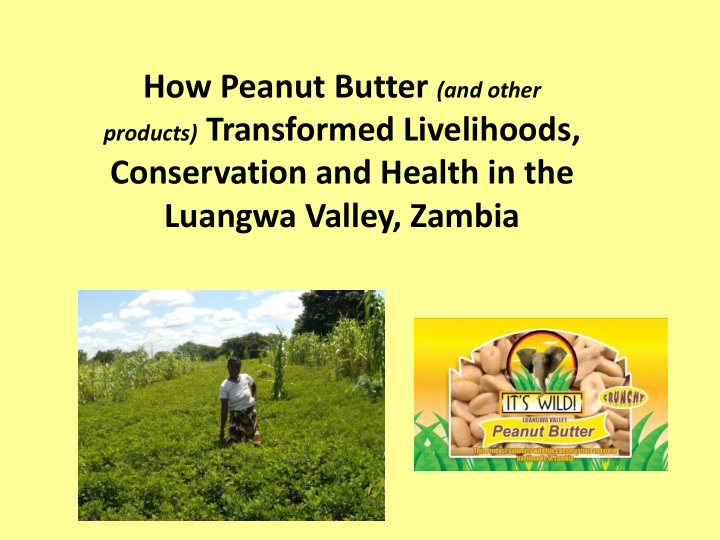



How Peanut Butter (and other products) Transformed Livelihoods, Conservation and Health in the Luangwa Valley, Zambia
Community Markets for Conservation (COMACO Ltd.) 66,995 farmer members Sales in 2012-13FY: $2.71 million A brand promise of delivering healthy, pesticide-free food products derived from farmers who feed themselves, take care of their soils, and stop poaching .
Organizational elements: Producer groups: 3,939 Lead farmers: 1,139 Bulking centres: 259 Community trading depots: 58 Farmer Support Centers: 7 Manufacturing hubs: 4 Sales and distribution centres: 2
Land use Practices an Environmental Threats
The transformation process… Small-scale farmer Business Trading centers Sales centers Marketing Product Farm Crop Soil Increased Transaction Sales, practices divers. improv. yields Storage manufact. accounts at local depots Conservation incentives Trade benefits Dividend Commodity price
COMACO Farming: The Wrong Approach • Non-food crop farming • Mono-culture approach with dependence on fertilizers and pesticides • Long fallow period • Ridge-farming, high labour • More prone to drought • Low yield without fertilizer • Poor understanding of soils
COMACO Farming: The RIght Approach • Low tillage, water conservation • Crop rotation with legumes using agroforestry • Mulching • Composting • No-burning
The business behind the transformation process COMACO
Cost to service a farmer: $30-35/yr
Correlated environmental trends Firearms surrendered: 2069 Snares surrendered: 80,220
“Broad-stroke” livelihood impact • Food insecurity led to hunger and poverty. • 50% of children in Eastern Province are underweight • Zambia’s fertility rate is 6.2 children per family with low contraceptive use • Health outposts are often 12 kilometers from the community • Need to link health, food security, markets with conservation Farmers (lead Consumers farmers, producer groups) Bulking Depot Farmer Support Center/ Sales Retail points Manufacturing hub Centre stores
“Broad-stroke” livelihood impact • Increased food-crop yields (30-40%) • Increased income and income source • crop diversification • 65% adoption of sustainable agriculture practices • group knowledge sharing, • increased leadership activity by women, • increased family stability
Added social impact from the COMACO approach Better Life Books: covers tops of agriculture, off-farm income activities, nutrition, family health, family planning Distributed to over 3000 producer groups Lead farmers direct the use and training from these books Supplemented by radio broadcasts
Fueling social impact with partners ( Balance Project and Flex Fund) • Lead farmers (Adult Peer Educators) have become agents for local clinics to distribute family planning products • MOU with Ministry of Health for COMACO to be agents of local clinics for FP products • Thousands of women now understand their reproductive health and many are able to avoid pregnancies • 1000’s of condoms and 100’s of pills distributed to current users. Hundreds of referrals for new users. • 2.5 year program and cost $90,000
Other partners General Mills : R&D for new products, food safety, supply chain, production design, etc. Cornell University: R&D for new products, food safety, village chickens research, social surveys USAID and Royal Norwegian Embassy: Compliance standards, M&E support Cquest: Carbon market development
Summary - What have we learned? • It starts with loving the farmer (stop vilifying the poacher!) • Focus on food security and soils • Value-added markets, as opposed to commodity markets, will probably drive the COMACO approach • Consumers can be integrated into the solution with the right marketing and with good products • Small farmers can be our best conservation allies • COMACO structure provides important avenues for on-going social improvement
Summary - What have we learned? • Science and technology are available through partners who see opportunistic synergies with COMACO • Needs a corporate governance structure accountable to a business plan and the Brand Promise • COMACO is a robust, holistic model that reduces donor costs over time • It requires donor support for a least 10 years with a commitment of $10-15 million • Conservation results are largely a zero-cost by-product, enhanced with compliance related, added incentives
Challenges • Sustainability requires scale, introduces risks and increased costs and complexities • Commitment to a supply chain originating from small farmers, often in remote places • Requires highly talented, motivated professionals to lead it and manage it – can be hard to find such people • Complex approach that is cross-cutting and requires broad understanding of different disciplines
Challenges • There will be disasters, need to have a strong team to weather through • Difficult to find investors and not easy to sustain growth with a model that is not purely for profit • There is urgency to grow the model because environmental clock is ticking, investors tend to think purely business and risk avoidance • We need more social capital in the market to help finance enterprises like COMACO
Recommend
More recommend